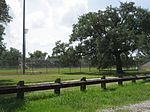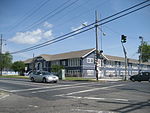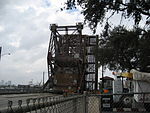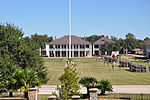Naval Support Activity New Orleans

Naval Support Activity New Orleans was a United States Navy installation until September 2011. During its time in operation, it was the largest military installation in greater New Orleans. It hosts activities for other branches of service and federal agencies. The installation met the needs of military personnel, both in and behind the battle. Home to nearly 3900 active-duty and 2,700 civilian personnel, the facility spreads over both banks of the Mississippi River. NSA New Orleans was previously home to: Commander, Naval Reserve Force (later Navy Reserve Forces Command) Commander, Naval Air Force Reserve Commanding Officer, Naval Reserve Personnel Center Commanding General, Marine Forces Reserve Commanding General, 4th Marine Aircraft Wing Commanding General, 4th Marine DivisionThe base was previously home to Commander, Navy Reserve Forces Command, until that command's relocation to Naval Station Norfolk, Virginia in March 2009 pursuant to the 2005 Base Realignment and Closure (BRAC) Commission. Commander, Naval Air Force Reserve was relocated to Naval Base Coronado / Naval Air Station North Island alongside Commander, Naval Air Forces and the Naval Reserve Personnel Center was disestablished and its activities merged with the active duty Bureau of Naval Personnel / Navy Personnel Command (BUPERS / NAVPERSCOM) at NSA Mid-South in Millington, Tennessee. The aforementioned Marine Corps organizations have remained at the former NSA New Orleans following its transition/conversion to a "Federal City" complex. Established in the early 1900s, but inactive for long periods, the facility was reborn in 1939. Between 1944 and 1966, the base progressed from a U.S. Naval Station to the Headquarters, Support Activity, New Orleans. In 1966, the Army, which owned the property on the river's east bank, transferred ownership to the Navy, thus establishing the command known as Naval Support Activity New Orleans. Base housing was limited to 300 units. Other amenities included a 22-unit Navy Lodge transient billeting facility, a Family Service Center, a childcare center for 42 children, a medium-sized commissary, a Navy Exchange, and a Naval Medical Clinic. Recreational activities included an arts and crafts center, auto hobby center, and a base library.
Excerpt from the Wikipedia article Naval Support Activity New Orleans (License: CC BY-SA 3.0, Authors, Images).Naval Support Activity New Orleans
Mississippi River Trail, New Orleans
Geographical coordinates (GPS) Address Nearby Places Show on map
Geographical coordinates (GPS)
| Latitude | Longitude |
|---|---|
| N 29.95 ° | E -90.029166666667 ° |
Address
Mississippi River Trail
Mississippi River Trail
70131 New Orleans
Louisiana, United States
Open on Google Maps








